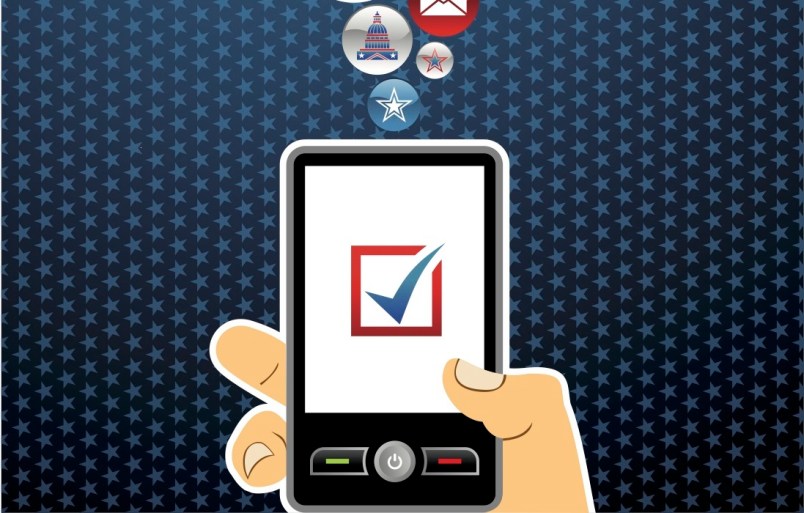A smartphone app could end the voting wars – but only if Republicans are willing to let all adult citizens vote.
Yesterday, a federal judge invalidated Wisconsin’s voter ID law.
While voter ID opponents, myself included, could not be happier, Judge Lynn Adelman’s words will not be the last on the issue. Both sides are gearing up for appeals that could go as high as the Supreme Court. Meanwhile, groups of Republican lawmakers will continue to push voter ID laws in other states, and Democrats and civil rights groups are organizing to resist them.
It does not have to be like this. Ironically, half the solution to the voter ID crisis is already law in Wisconsin. And the other half is sitting in your pocket.
Ideally, of course, Americans would not need to have this debate at all. After all, Judge Adelman’s argument was powerful: if people have no ID, they cannot vote. In a nation with no national ID card, where most IDs cost money to obtain, where 1 in 7 people live in poverty, and where poverty disproportionately hits African Americans and Latinos, ID laws have a discriminatory impact. Some people will inevitably show up to vote without ID, and be barred from voting. Given that there is no evidence of meaningful in-person fraud in American elections, voter ID laws do much more harm than good.
But here is the problem: Americans overwhelmingly back voter ID laws. In March, Rasmussen found that some 78 percent percent of Americans back laws requiring voters to show ID – and Rasmussen’s numbers are no fluke. A Washington Post poll found similar levels of support in 2012.
But what if a person who lacks ID could show up at the polls and get one? Then a state could require ID, but still let every citizen vote.
Wisconsin and 11 other states already have same-day voter registration, a system that lets citizens register on Election Day. Same-day registration laws have a four-decade track record of success. Voters seem to like being able to register on Election Day: citizens in Maine for example, overwhelmingly voted to keep their system in place when confronted with a ballot questions on the issue in 2011.
Election Day Registration is ingredient number one for ending the voter ID wars.
The second ingredient is a smartphone app for creating voter IDs on the spot. High-resolution camera phones are increasingly cheap. A simple app could use existing iPhone and Android systems to let poll workers take a picture and create an ID for any voter who shows up without one. Add a $10 desktop mounted camera stand and you are in business. Such systems could be integrated with online voter registration systems that are becoming increasingly popular in state after state.
Here is how the system would work on Election Day. Most registered voters would arrive at the polls, show an ID, and vote normally. For them – on the order of 90 to 95 percent of all voters – nothing at all would change. Citizens who have never registered, or voters who need to update their name (perhaps because of a marriage) or their address could take advantage of Election Day Registration, fill out a form, and vote. And citizens without ID could have their picture taken, and sign a form swearing to their identity and eligibility. Indeed, these forms can also be part of the app, signed with a finger, the way farmers market vendors take credit card signatures. A few weeks after Election Day, the state could mail out ID card that citizens can keep for future Elections if they wish.
An app for voter IDs, coupled with Election Day Registration, has something for everyone. Voter ID supporters get what they say they want – a picture ID for every voter, and, in case of anything fishy, an actual photo and sworn statement that provides ample information for follow-up investigations. And election administrators end up with cleaner, more accurate voting rolls.
Everyone else gets something, too. Election Day Registration is the gold standard when it comes to promoting voter participation.
Given the wins for all concerned, a compromise voting law like this should be easy. But there’s a catch: what if voter ID proponents don’t actually want voter ID at all, but just see it as a means to the end of reducing the number of Democratic-leaning people of color who vote? What if some Democrats who say they want to maximize turnout among people of color really just want to that maintain that turnout at, say, 2012 levels, but are frightened by the notion of truly increasing participation?
If innovative legislators and election reformers push Election Day Registration coupled with voter ID and instant ID apps, the truth will out.
Avi Green is Co-Chair of the Scholars Strategy Network Working Group on Protecting and Expanding the Right to Vote.
—
Photo: Shutterstock/Cienpies Design







“What if some Democrats who say they want to maximize turnout among people of color really just want to that maintain that turnout at, say, 2012 levels, but are frightened by the notion of truly increasing participation?” Talk about desperate attempts at false balance. Democrats devote most campaigning to getting more people to vote. Surely the author knows that.
Though I like this idea a lot, any article discussing how to improve voting tends to annoy me. In Oregon we already solved the problem! Everyone needs to move to Oregon’s system where the state mails you your ballot and you either mail it back or drop it off somewhere nearby. All other ideas are moot.